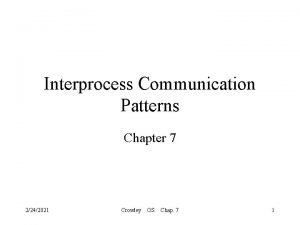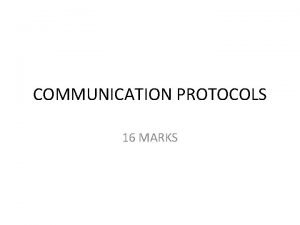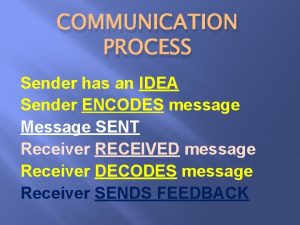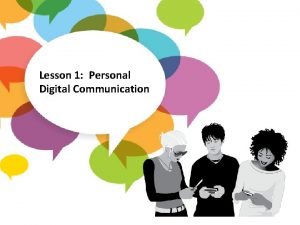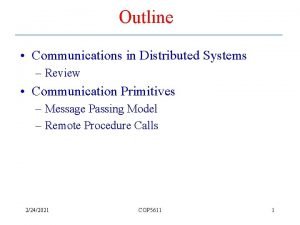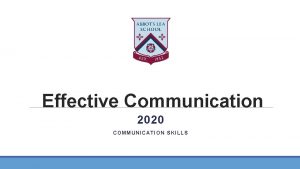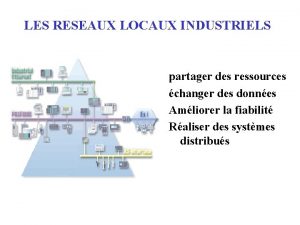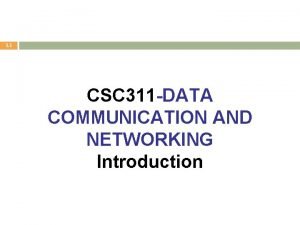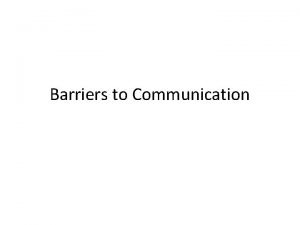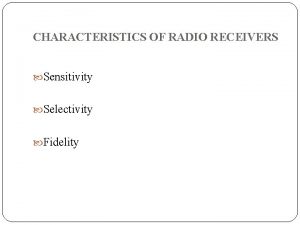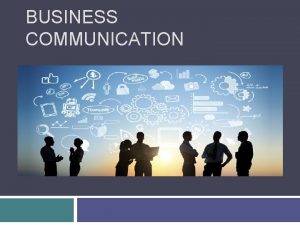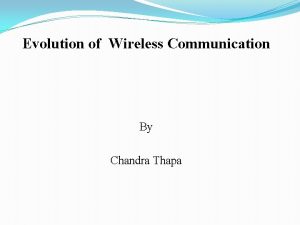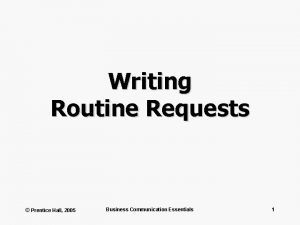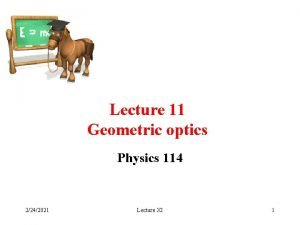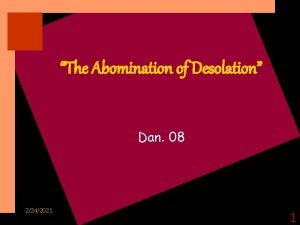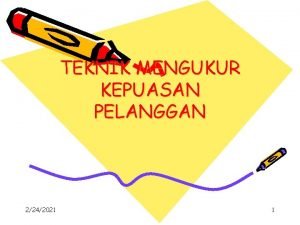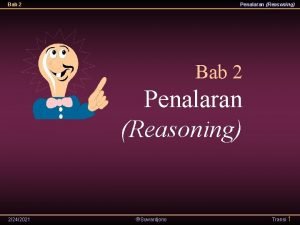COMMUNICATION 2242021 communicationRenita 1 What is communication Communication






























- Slides: 30

COMMUNICATION 2/24/2021 communication-Renita 1

What is communication? • Communication is the process whereby speech, signs or actions transmit information from one person to another • Communication is about sending and receiving information or the transmission of information and meaning from one party to another through using shared symbols. 2/24/2021 communication-Renita 2

DEFINITION “Communication refers to the reciprocal exchange of information, ideas, feelings and attitudes between two persons or among a group of persons” ---Taylor 1994. 2/24/2021 communication-Renita 3

Definition of communication Communication is “a process by which two or more people exchange ideas, facts, feelings or impressions in ways that each gains a ‘common understanding’ of meaning, intent and use of a message. ” Paul Leagens 2/24/2021 communication-Renita 4

Major Dimensions of Communication • Content (what type of things are communicated) • Source (by whom) • Form (in which form) • Channel (through which medium) • Destination/Receiver (to whom) 2/24/2021 communication-Renita 5

Communication process model Sender Message Channel Medium Receiver Feedback © Photo. Disc 2/24/2021 communication-Renita 6

1. Sender • The sender (communicator) is the originator of the message. • Sender formulates, encodes and transmits the information which he/she wants to communicate. • The impact of the message will depend on sender's communication skill, social status (authority), knowledge, attitude and prestige in the community. 2/24/2021 communication-Renita 7

2. Message • A message is the information/desired behaviour in physical form which the communicator transmits to his audience to receive, understand, accept and act upon. • The message may be in the form of words, pictures or signs. 2/24/2021 communication-Renita 8

A good message must be: – In line with the objectives – Meaningful – Based on felt needs – Clear and understandable – Specific and accurate – Timely and adequate – Fitting the audience – Interesting – Culturally and socially appropriate 2/24/2021 communication-Renita 9

3. Channels of Communication • “Physical bridge” or the media of communication between sender and the receiver. • Channels can be: – Interpersonal (face to face communication) may be verbal or nonverbal, or – Mass media TV, radio, printed media etc. • Every channel of communication has its advantages and limitations. • The proper selection and use of channels results in successful communication. 2/24/2021 communication-Renita 10

4. Reciever • Who receives messages from the sender, decoding, interprets the meaning and giving feedback. 5. Feedback • It is the flow of information from receiver to the sender, the reaction to the message. 2/24/2021 communication-Renita 11

COMMUNICATION On the basis of Relationship On the basis of flow Formal informal vertical 2/24/2021 Downward upward On the basis of expression verbal horizontal communication-Renita oral nonverbal written 12

Types of communication • One-way Communication • Two-way Communication both sender and receiver take part. 2/24/2021 communication-Renita 13

One-way Communiaction (didactic) the flow of communication is “one-way” from the communicator to the receiver. Eg. Lecture method. • Advantages • One-way communication – Considerable faster than two-way communication – Appears neat and efficient to an outsider observer. – Sender is more psychologically comfortable – Plan-fullness, order, systemization are associated with. • Disadvantages – – – 2/24/2021 knowledge is imposed Learning is authoritative Little audience participation No feedback Little influence on human behaviour. communication-Renita 14

• A process in which information flows in two-directions –the receiver provides feedback and the sender receptive to the feedback. Two-way communication • It is more accurate and fewer mistakes in transmission. • But it is time-consuming and more difficult for the sender. 2/24/2021 communication-Renita 15

Mode of Communication Verbal Communication • the traditional way of communication by mouth. • Language is the chief vehicle of communication. • "Effective verbal communication techniques" include – Clarity and brevity, Vocabulary, Denotative and connotative meaning, Pacing, Timing and relevance, Humour • Verbal communication also involves written words. Non-verbal communication • communication occur other than words. • facial expression, gesture, touch and vocal tone 2/24/2021 communication-Renita 16

Channels of communication • Information passes downwards or upwards in the organization. Vertical communication • Downward communication means that the manager tells employees about a decision that has been already made. It allows decisions to carried out quickly. • Upward communication refers to employees’ giving feedback to the manager about the decision. It helps managers to understand employees’ ideas on the 2/24/2021 decision. communication-Renita 17

Channels of communication Lateral/Horizontal communication 2/24/2021 • People in the same level within an organization pass information to each other. • It can strengthen the understanding and coordination between people in different departments. communication-Renita 18

Communication media • • • Written communication media Oral communication media Electronic communication media © Photo. Disc 2/24/2021 communication-Renita 19

Communication media • Communication through: Letters, Memos, Reports, Forms , Written communication Notice boards and Internal magazines or newspapers • Messages can be revised several times. • The sender can not receive immediate feedback. 2/24/2021 communication-Renita 20

Communication media Oral communication 2/24/2021 • Face-to-face discussions, telephone conservations, formal presentations and speeches • Advantages: Questions can be asked answered directly; feedback is immediate; and the sender’s attitude can be sensed. • Disadvantages: few permanent records communication-Renita 21

Communication media • Communication through electronic media such as mobile phone, paging devises, laptop, computers, E-mail, fax machines, and electronic Electronic communication notice boards • Messages can be delivered instantly, over long distances, and to a large number of people. • But not all people have can access to the media. © Photo. Disc 2/24/2021 communication-Renita 22

FACTORS INFLUENCING COMMUNICATION • Developmental factors - Age • Social factors- Gender, social class, Language, Power, Social roles, Education • Psychological factors -Emotions, Defense mechanisms, Attitudes, Assumptions, Prejudices, Perceptions 2/24/2021 communication-Renita 23

Factors Contd… • Cultural factors -Language, Ethnicity, custom, self expression patterns, values and beliefs • Environmental factors- Noise, Privacy, Comfort and safety, distraction • Situational factors- Stress, pain and discomfort, Fear and anxiety, Fatigue, Hearing impairment, selective listening. 2/24/2021 communication-Renita 24

Principles of communication: • Communication should have objective and purpose. • Should be appropriate to situation. • Systematic analysis of the message, i. e. , the idea, the thought to be communicated, so that one is clear about it. • Selection and determination of appropriate language and medium of communication according to its purpose. • Organizational climate, including appropriate timing and physical setting to convey the desired meaning of the communication. • Consultation with others for planning of communication; involves special preparation. 2/24/2021 communication-Renita 25

• Message should convey something of value to the receiver in the light of his needs and interests. • The communication action following a communication is important in effective communication as this speaks more than his/her words. • The sender has to understand the receivers attitude and reaction by careful, alert and proper listening to ensure that the desired meaning of the message has been comprehended by the receiver. • Credibility is very important. • Communication programme should make use of existing facilities to the great extent possible and should avoid challenging them unnecessarily. 2/24/2021 communication-Renita 26

Purposes of communication in nursing system: 1. To transfer information between patients and all classes of employees. 2. To interpret and adopt polices in the organization. 3. To include motivation, co-operation and co-ordination in the employees and patients. 4 to improve nurse-patient relationship 5. To recruit, select, train and develop the personnel in the organization. 6. To encourage participation in decision making. 7. To delegate or decentralize authority. 8. To boost the group morale of the workers 9. To ensure patient safety and job satisfaction. 10. To help the grievance procedure and disciplinary actions 2/24/2021 communication-Renita 27

Levels of communication. : 1. Intrapersonal communication- • self talk, • self instruction, 2. Interpersonal communication- • interaction between two people or in a small group. 3. Group communication: small group communication. • Organizational communication. 4. Public communication 2/24/2021 communication-Renita 28

2/24/2021 communication-Renita 29

THANK YOU 2/24/2021 communication-Renita 30
 2242021
2242021 Fc-2242021
Fc-2242021 Os
Os Abb industry oy
Abb industry oy 2242021
2242021 2242021
2242021 Parallel communication
Parallel communication Diff between oral and written communication
Diff between oral and written communication What is oral communication and written communication
What is oral communication and written communication Serial communication vs parallel communication
Serial communication vs parallel communication Parallel and serial communication difference
Parallel and serial communication difference Mass communication
Mass communication The sender encodes the idea
The sender encodes the idea Lesson 1 personal digital communication
Lesson 1 personal digital communication Communication primitives in distributed operating system
Communication primitives in distributed operating system Graded assertiveness cuss
Graded assertiveness cuss Structured systems analysis and design method
Structured systems analysis and design method Tone formality
Tone formality Physical barriers to communication
Physical barriers to communication Communication with oneself
Communication with oneself Couche osi tcp ip
Couche osi tcp ip Csc 311
Csc 311 What are the organizational barriers to communication
What are the organizational barriers to communication Sensitivity and selectivity of radio receiver
Sensitivity and selectivity of radio receiver Conclusion of oral communication
Conclusion of oral communication Business communication introduction
Business communication introduction Evolution of wireless communication
Evolution of wireless communication Prehospital emergency care 11th edition
Prehospital emergency care 11th edition Georgetown university cct
Georgetown university cct What is schematic report
What is schematic report Routine messages in business communication
Routine messages in business communication


